
A naval air station is a military air base, and consists of a permanent land-based operations locations for the military aviation division of the relevant branch of a navy. These bases are typically populated by squadrons, groups or wings, their various support commands, and other tenant commands.

Naval Air Station North Island or NAS North Island is located at the north end of the Coronado peninsula on San Diego Bay and is the home port of several aircraft carriers of the United States Navy. It is part of the largest aerospace-industrial complex in the United States Navy—Naval Base Coronado (NBC) in San Diego County, California.

The 3rd Marine Aircraft Wing is the major west coast aviation unit of the United States Marine Corps. It is headquartered at Marine Corps Air Station Miramar, in San Diego, California and provides the aviation combat element for I Marine Expeditionary Force. The wing is made up of a headquarters squadron, four flying groups, an aviation command and control group and an aviation engineering group.

The 1st Marine Aircraft Wing is an aviation unit of the United States Marine Corps that serves as the Aviation Combat Element of the III Marine Expeditionary Force. The wing is headquartered at Camp Foster on the island of Okinawa, Japan. Activated in 1940, the wing has seen heavy combat operations during World War II, the Korean War and the Vietnam War.
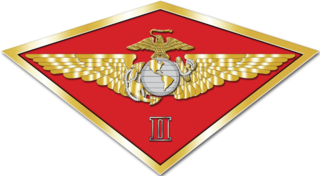
The 2nd Marine Aircraft Wing is the major east coast aviation unit of the United States Marine Corps and is headquartered in Marine Corps Air Station Cherry Point, North Carolina. The Wing provides the aviation combat element for the II Marine Expeditionary Force.

Marine Fighter Attack Squadron 142 (VMFA-142) was an aviation unit of the United States Marine Corps Reserve that was active from 1942 to 2008. At the time of its inactivation, the squadron was based at Naval Air Station Atlanta, Georgia and fell under the command of Marine Aircraft Group 42 (MAG-42), 4th Marine Aircraft Wing. Due to a re-organization within Marine aviation, the squadron moved to Naval Air Station Fort Worth Joint Reserve Base, Texas and was placed in a cadre status under Marine Aircraft Group 41.
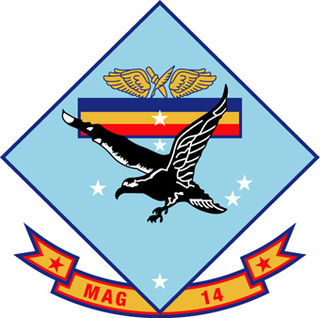
Marine Aircraft Group 14 (MAG-14) is a United States Marine Corps aviation unit based at Marine Corps Air Station Cherry Point, North Carolina that is currently composed of four AV-8B Harrier squadrons, one F-35C squadron, one UAV squadron, one KC-130 squadron, and an aviation logistics squadron.

Marine Aircraft Group 31 (MAG-31) is a United States Marine Corps aviation group based at Marine Corps Air Station Beaufort, South Carolina that is currently composed of two F/A-18C Hornet squadrons, one F/A-18A++ Hornet squadron, two F/A-18D Hornet squadrons, one F-35B Lightning II training squadron, an aviation logistics squadron, and a wing support squadron. It falls under the command of the 2nd Marine Aircraft Wing.

Marine Air Control Squadron 4 (MACS-4) is a United States Marine Corps aviation command and control squadron that provides aerial surveillance Ground-controlled interception and air traffic control for the III Marine Expeditionary Force. Originally formed in World War II, the squadron's most notable combat operations occurred during the Vietnam War when it was the first unit to ever use the Marine Tactical Data System. They are currently based at Marine Corps Air Station Futenma and fall under the command of Marine Air Control Group 18 and the 1st Marine Aircraft Wing.

Marine Aviation Training Support Group 23 (MATSG-23) is a United States Marine Corps aviation training group originally established during World War II as Marine Aircraft Group 23 (MAG-23). Squadrons from MAG-23, augmented by Navy and Army flying units formed the Cactus Air Force during the Battle of Guadalcanal. Since then it has evolved into the first Aviation Logistics focused Colonel level command, and serves as a functional training advocate for all USMC Aviation Logistics entry-level training. The instructors and support staff of MATSG-23 are responsible for training thousands of Marines per year in the disciplines required to enable the expeditionary aviation required to support the Marine Air Ground Task Force.
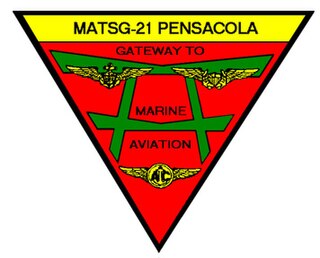
Marine Aviation and Training Support Group 21 (MATSG-21) is a United States Marine Corps aviation training group that was originally established in 1922 as the 2nd Aviation Group. During World War II the unit was known as Marine Aircraft Group 21 (MAG-21). Squadrons from MAG-21 fought in many of the opening battles of the war to include the Battle of Wake Island, Battle of Midway and as part of the Cactus Air Force during the Battle of Guadalcanal The group was deactivated following the end of the war and was not reactivated until 2000 when the Marine Aviation Detachment at Naval Air Station Pensacola, Florida was renamed MATSG-21. The core of the MATSG personnel is derived from 175 officer instructors and 550 student naval aviators/naval flight officers.

Marine Aviation and Training Support Group 33 (MATSG-33) is a United States Marine Corps aviation training group that was originally established during World War II as Marine Aircraft Group 33 (MAG-33). Fighter squadrons from MAG-33 fought most notably during the Battle of Okinawa and also as the first Marine aviation units to support the Korean War when they arrived as part of the 1st Provisional Marine Brigade. They helped stabilize the United Nations positions during the Battle of Pusan Perimeter and fought in Korea for the remainder of the war. At some point in the 1960s, the group was deactivated and was not reactivated until 2000, when Marine Aviation Training Support Group at Naval Air Station Oceana, Virginia was renamed MATSG-33.

Commander, Naval Air Force Atlantic is the aviation Type Commander (TYCOM) for the United States Naval aviation units operating primarily in the Atlantic under United States Fleet Forces Command. Type Commanders are in administrative control (ADCON), and in some cases operational control (OPCON) of certain types of assets assigned to the Pacific and Atlantic Fleets. AIRLANT is responsible for the material readiness, administration, training, and inspection of units/squadrons under their command, and for providing operationally ready air squadrons and aircraft carriers to the fleet.
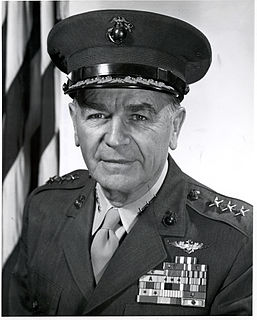
John Calvin Munn was the 8th Assistant Commandant of the Marine Corps and United States Naval Aviator. He served for 37 years in the United States Marine Corps.

William Jennings Wallace was a highly decorated aviation officer of the United States Marine Corps with the rank of lieutenant general. He is most noted for his service as commanding officer of MAG-22 at Midway and MAG-23 at Guadalcanal and the Air Defense Command during the Battle of Okinawa.
Department of the Pacific (MarPac) was a United States Marine Corps ground training and administrative command established on November 15, 1920, which was responsible for the administration, training and equipment of the Marine Corps Units on the West Coast, 14th Naval District, 16th Naval District, 17th Naval District and Marine Forces in Northern China.

Stanley Emanuel Ridderhof was a highly decorated naval aviator of the United States Marine Corps with the rank of brigadier general. A veteran of many conflicts, Ridderhof enlisted in the Marine Corps during World War I and received commission soon after. He then served in Nicaragua and received Navy Cross, the United States military's second-highest decoration awarded for valor in combat. During World War II, he served various assignments in the Pacific theater and received Distinguished Flying Cross and other decorations.
Marine Aircraft Group 43 (MAG-43) was a fixed wing aviation group in the United States Marine Corps Reserve based at Naval Air Station Joint Reserve Base Willow Grove, Pennsylvania.
Air Warning Squadron 4 (AWS-4) was a United States Marine Corps aviation command and control squadron during World War II. The squadron's primary mission was to provide aerial surveillance and early warning of approaching enemy aircraft during amphibious assaults. The squadron participated in the Philippines campaign (1944–1945) in support of the Eighth Army on Mindanao. AWS-4 was decommissioned shortly after the war in October 1945. To date, no other Marine Corps squadron has carried the lineage and honors of AWS-4 to include Marine Air Control Squadron 4 (MACS-4).
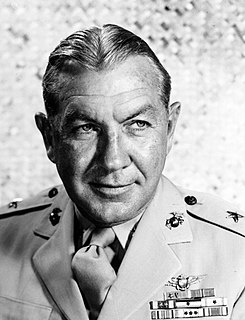
David Ferguson O'Neill was a decorated Naval aviator and officer in the United States Marine Corps with the rank of major general. A veteran of World War II, he commanded Strike Command, Aircraft Solomons on Guadalcanal, New Britain and Bougainville and received several decorations for his service.























